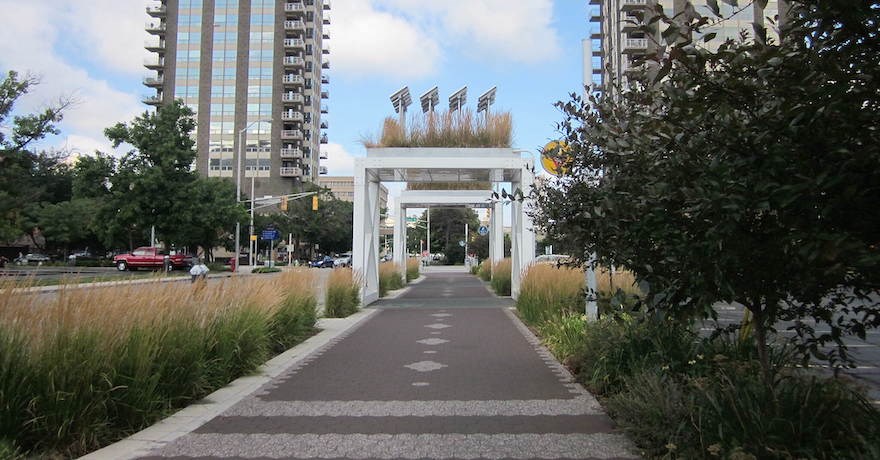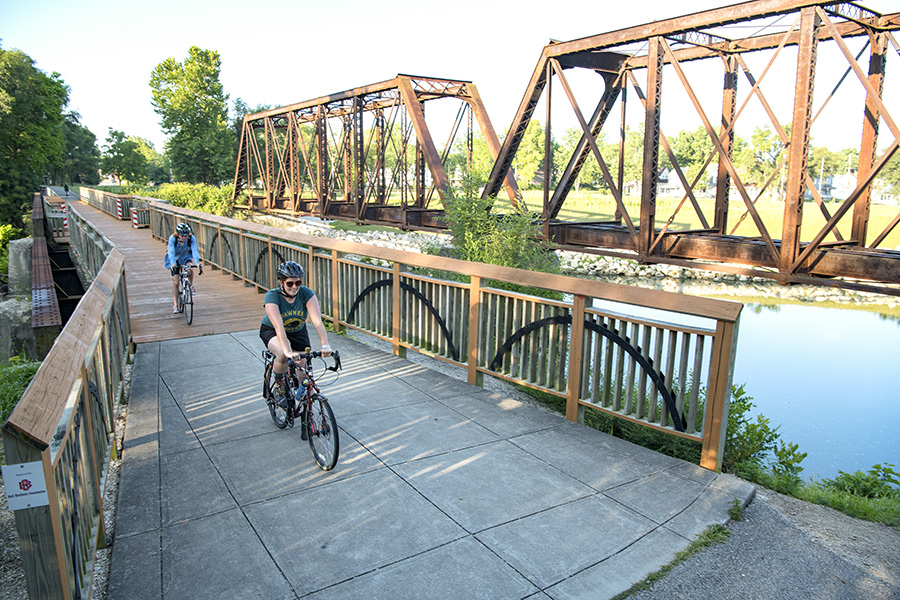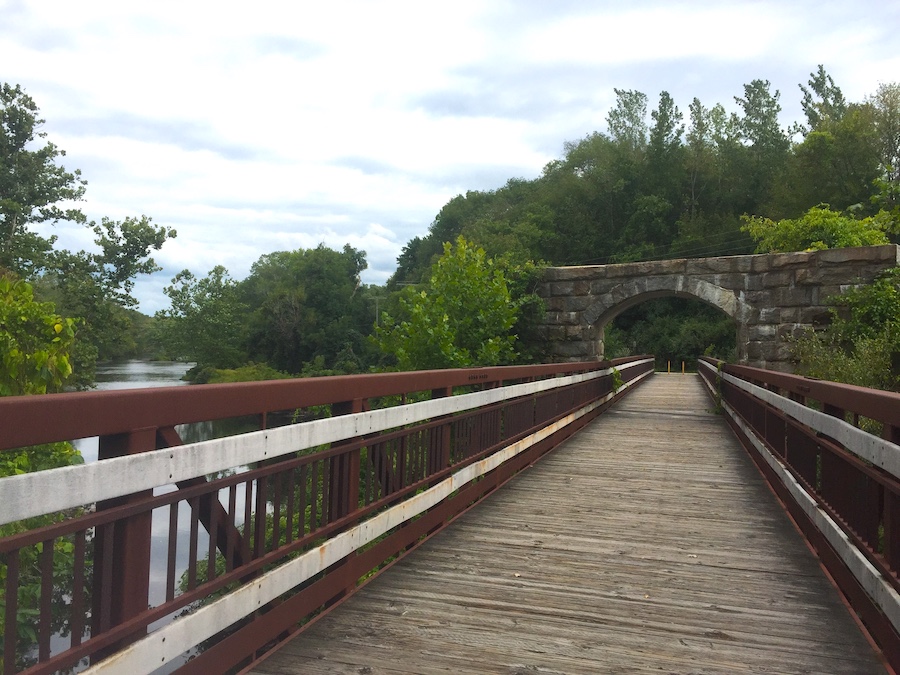Statewide Trail Planning
Many states create trail plans to establish their trail goals and objectives, outline a proposed statewide network, and provide insight into their funding allocations and prioritization. It’s been demonstrated time and again that states with trail plans that are robust and updated regularly have more power behind decisions to invest in trail development and create comprehensive trail networks.
Having a statewide trail plan doesn’t automatically mean that a state’s trails are built faster, are better maintained and are well-used; it takes the dedication of agency staff and elected officials to allocate the resources to make these things possible. However, planning helps make those goals a reality.
What Is a Statewide Trail Plan?

The main role of a statewide trail plan is to communicate the state’s priorities for planning, operating and funding trails. Many states look to inventory their existing trail network and create a set of criteria to guide its development and expansion. This process typically involves creating a needs assessment and conducting public engagement sessions to understand the public’s wishes for the state’s trail network.
Some states are directly involved as the manager of one or more trails, which requires its own level of planning. States like Wisconsin, Nebraska, Missouri and Washington manage several long-distances trails as state parks. These states need to plan for the long-term management and operations of these trails, which can be included in their statewide trail plans.
Because comprehensive statewide trail planning is not federally mandated, each state chooses the level of planning they’d like to conduct, creating a patchwork of trail plans across the United States. In a review of statewide trail plans in 2023, it was found that 30 states have dedicated plans (19 of which have been updated since 2013). A total of 12 states and the District of Columbia also have specific bicycle/pedestrian or active transportation plans that might cover trails, while the remaining eight states only focus statewide trail planning in their Statewide Comprehensive Outdoor Recreation Plans, or SCORPs. These plans vary greatly between states because states are not required to conduct trail-specific planning, and there are no uniform guidelines for states to follow for those that do. It is up to each state to decide if they value the need for trail planning and how they would like to conduct it. Complicating trail planning efforts, trails tend to be within the scope of both transportation and natural resources agencies. States where trail planning is done best and most comprehensively establish clear partnerships between these agencies, while the ambiguity and overlapping scopes allow trail planning to slip through the cracks in other places.
Statewide Trail Planning Through Other Documents and Processes

While states are not required to conduct trail planning, there are several required planning processes that do typically include trails. If a state does not specifically create a trail plan, related plans may be included in these documents.
The United States Department of Transportation (USDOT) requires several statewide transportation planning documents that may or may not include trails and active transportation.
State Transportation Improvement Programs (STIPs) are the compilation of Transportation Improvement Programs (TIPs), created by metropolitan planning organizations (MPOs), that outline current projects that expand, maintain and/or upgrade the state’s transportation system. To qualify for federal transportation funding, each state is required to create a STIP that covers a period of at least four years and specifically includes information on project funding. The USDOT requires multimodal projects to be included in STIPs and views these projects as part of a state’s transportation system, but trails are not specifically included in this regulation.
Each state must prepare a Long-Range Transportation Plan (LRTP). These plans serve as a vision for the state’s transportation system over the next 20 or more years, including transit, highway, bicycle, pedestrian and accessible transportation. Given the plan’s time horizon, they do not include every transportation project, but the plan must identify how the transportation system will meet the state’s economic, transportation, development and sustainability goals.
Statewide Comprehensive Outdoor Recreation Plans (SCORPs) are another type of mandatory statewide plan. SCORPs are required every five years for states to be eligible for funding under the Land and Water Conservation Fund within the National Park Service (NPS). SCORPs assess the need and use of outdoor recreation resources in the state and identify state priorities for outdoor recreation investments. NPS recommends that trails are included in SCORPs, but since it is not a requirement, the scope of trail planning within SCORPs varies greatly. Indiana’s statewide trail plan is contained as a chapter in its SCORP.
Using Trail Plans to Prioritize Funding Allocations
Trail plans can be used to guide the allocation of specific funding sources, such as a state’s own trail grants, and their Recreational Trails Program and Transportation Alternatives funding, received from the USDOT. Trail projects that match priorities in statewide plans can be more likely to receive funding. For example, Arizona uses a priority system to give projects that align with their priorities more points when scoring projects for grants. Other states use trail plans to create a priority network of trails on which to focus their funding. For example, Indiana’s Visionary Trail System identifies trails the state is trying to help local and regional groups finish; that prioritization is then used as one of many criteria in reviewing applications for the Indiana Trails Program, which is facilitated by the Indiana Department of Natural Resources.
The goals communicated in trail plans increase funding transparency, allowing trail managers and advocates to better understand the kinds of trail projects the state prioritizes.
The priorities highlighted in state plans may only be relevant to programs within the authoring agency, although cross-agency collaboration in plan development should be a goal. Natural resources, transportation, and parks and recreation departments, among others, are all possible authors of statewide plans. The authoring agency will impact the funding opportunities discussed in the plan and should be considered when engaging in the process.
Ways to Be Involved in the Planning Process

Since statewide trail plans can accelerate trail development, it is important that advocates play a role in the plan’s creation. Participating in public engagement opportunities is the most effective way an advocate can influence a state trail plan and ensure the plan matches their needs. Three of the main public engagement opportunities commonly used for statewide trail planning are surveys, town halls and task forces/advisory committees.
Surveys gather general data about trends and patterns of trail use as well as which trail needs should be prioritized. Surveys are usually the first part of the state planning process, so people advocating for trails should check state agency websites for updates on timelines of surveys and pay attention to related agency outreach efforts. Trail advocates should also share surveys with their networks to help the state reach as many people as possible, thereby giving the state a clear picture of their communities’ needs.
Town halls are another common form of public engagement, and agencies typically invite all types of stakeholders to attend. Town halls offer a chance for people advocating for trails to interact directly with state officials. These sessions often include state officials presenting information about the trail plan process or the agency’s goals, allowing trail advocates to familiarize themselves. There may also be opportunities for advocates to share information about specific trail projects in order to have them placed on state priority maps or provide input on priorities gathered from surveys.
Finally, task forces and advisory committees are the most involved ways a person can participate in the trail planning process as an advocate. States may appoint specific people to the group or leave them open to the public. Task forces in particular provide many opportunities for trail advocates to work closely with the lead agency because members provide direct feedback on aspects of the plan before it is released to the public. Proximity to state officials allows advocates to influence the priorities that states focus on.
A Selection of Statewide Trail Plans
- Connecticut’s trail plan was created by the Department of Energy and Environmental Protection, the state’s administrating agency for the Recreational Trails Program. Connecticut’s plan includes a transparent discussion of the state’s priority considerations for awarding trail project funding. It is common that the same agency that administers Recreational Trails Program funding is the agency that creates and implements a statewide trail plan.
- Arizona is required by statute to update their trail plan every five years, partially to prioritize and guide the funding of Arizona’s Off-Highway Vehicle Recreation Fund. This kind of clear direction ensures that maintaining an updated plan remains an important role of the planning agency.
- The main priority for the Florida Greenways and Trails System Plan is to create a statewide trail network. With regular updates to the plan, Florida’s Office of Greenways and Trails (within the state’s Department of Environmental Protection) ensures that trail projects at different stages of development are recognized for their importance to the statewide network.
- Maryland’s Department of Transportation released their State Transportation Trails Strategic Plan in 2025, outlining a vision for a “safe and accessible transportation trail network that connects Marylanders to opportunities across their communities, towns, and the state.” The plan focuses on transportation trails—shared-use paths that connect to everyday destinations. One notable feature of the plan is its set of Trail Toolkits, which address common challenges in trail development such as building support, securing funding and ensuring long-term maintenance. Each toolkit offers practical tools and strategies and includes case studies from across the state.
Resources
‣ Plan – Arizona 2025 Trails Plan
‣ Plan – Arizona 2020 Trails Plan
‣ Plan – North Carolina Great Trails State Plan (2022)
‣ Plan – Maryland State Transportation Trails Strategic Plan (2025)
TrailNation Collaborative
TrailNation™ Collaborative is a nationwide peer learning community from Rails to Trails Conservancy that brings together advocates, leaders and professionals from across disciplines to establish and accelerate trail networks across America. The collaborative provides proven tools, methods and resources, combined with RTC’s expertise and network of partners across the country, to accelerate the development of connected trail systems. When trails are connected across regions and states, trail networks have a proven transformative impact—they are essential infrastructure that creates thriving, healthier communities.